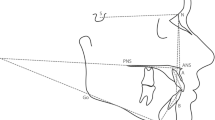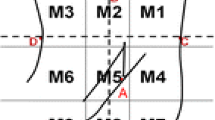Abstract
Purpose
It is well documented that the mandible does not grow at a constant rate. There are significant correlations between the increase of mandibular size and cervical vertebral maturation. The peak growth velocity of the mandible occurs after the third stage of cervical vertebral maturation. The location of the mandibular foramen (MF) and its changes subsequent to growth are of great interest to clinicians as they relate to the anesthesia of the inferior alveolar nerve and to mandibular surgical procedures. Therefore, the aim of the present study was to assess the influence of the mandibular growth spurt on the location of the MF in various skeletal growth patterns.
Methods
Panoramic and lateral cephalometric radiographs of 98 (32 orthognathic, 50 retrognathic, 16 prognathic) patients before and after the growth peak were collected. For each subject, the maturational stage of the cervical vertebrae was defined on successive lateral cephalograms and the vertical and horizontal position of the MF was evaluated on two panoramic radiographs, one before and one after the growth peak.
Results
The MF-Post/MF-Ant ratio (MF distance to the posterior border of the ramus/MF distance to the anterior border of the ramus) significantly increased after the growth peak in orthognathic and retrognathic subjects (P = 0.015 and 0.02, respectively). This ratio did not significantly increase in prognathic subjects (P = 0.882). No statistically significant changes in the vertical position of the MF were found in the three groups after the growth spurt.
Conclusion
The horizontal position of the MF moves in an anterior direction in orthognathic and retrognathic subjects during the mandibular growth spurt. The vertical position of the mandibular foramen remains unchanged during this period.
Zusammenfassung
Ziel
Dass der Unterkiefer nicht mit konstanter Geschwindigkeit wächst, ist eindeutig belegt. Es gibt signifikante Korrelationen zwischen dem Größenwachstum des Unterkiefers und der Reifung der Halswirbelsäule. Die maximale Wachstumsgeschwindigkeit erreicht der Unterkiefer nach der dritten Stufe der Halswirbelreifung. Die Lage des Foramen mandibulae (MF) und seine wachstumsbedingten Veränderungen sind für klinische Therapeuten von besonderem Interesse, denn sie stehen im Zusammenhang mit der Anästhesie des N. alveolaris inferior und mit chirurgischen Eingriffen am Unterkiefer. Ziel der hier vorgestellten Studie war es daher, den Einfluss des mandibulären Wachstumsschubs auf die Lage des MF bei verschiedenen skelettalen Wachstumsmustern zu untersuchen.
Methoden
Von 98 Patienten (32 orthognath, 50 retrognath, 16 prognath) wurden Orthopanthomogramme und seitliche Fernröntgenaufnahmen vor und nach dem Wachstumsmaximum angefertigt. Bei jedem Probanden wurde das Reifestadium der Halswirbel auf aufeinanderfolgenden seitlichen Fernröntgenbildern bestimmt. Die vertikale und horizontale Position der MF wurde auf 2 Panoramaröntgenbildern bewertet, eines vor und eines nach dem Wachstumsmaximum.
Ergebnisse
Das MF-Post/MF-Ant-Verhältnis (MF-Abstand zum hinteren Rand des Ramus/MF-Abstand zum vorderen Rand des Ramus) nahm nach dem Wachstumsmaximum bei orthognathen und retrognathen Patienten signifikant zu (p =0,015 bzw. 0,02). Bei prognathen Probanden nahm dieses Verhältnis nicht signifikant zu (p =0,882). In den 3 Gruppen wurden nach dem Wachstumsschub keine statistisch signifikanten Veränderungen der vertikalen Position der MF festgestellt.
Schlussfolgerung
Die horizontale Position der MF verschiebt sich bei orthognathen und retrognathen Probanden während des mandibulären Wachstumsschubs nach vorn. Die vertikale Position des Foramen mandibulae bleibt in diesem Zeitraum unverändert.


Similar content being viewed by others

References
Mitani H, Sato K (1992) Comparison of mandibular growth with other variables during puberty. Angle Orthod 62:217–222. https://doi.org/10.1043/0003-3219(1992)062〈0217:COMGWO〉2.0.CO;2
Ekström C (1982) Facial growth rate and its relation to somatic maturation in healthy children. Swed Dent J Suppl 11:1–99
Hägg U, Pancherz H, Taranger J (1987) Pubertal growth and orthodontic treatment. In: Carlson DS, Ribbens KA (eds) Craniofacial growth during adolescence. Craniofacial growth series, Monograph 20. Center for Human Growth and Development, The University of Michigan, Ann Arbor, pp 87–115
Franchi L, Baccetti T, McNamara JA Jr (2000) Mandibular growth as related to cervical vertebral maturation and body height. Am J Orthod Dentofacial Orthop 118:335–340. https://doi.org/10.1067/mod.2000.107009
O’Reilly MT, Yanniello GJ (1988) Mandibular growth changes and maturation of cervical vertebrae:—a longitudinal cephalometric study. Angle Orthod 58:179–184. https://doi.org/10.1043/0003-3219(1988)058〈0179:MGCAMO〉2.0.CO;2
Ashkenazi M, Taubman L, Gavish A (2011) Age-associated changes of the mandibular foramen position in anteroposterior dimension and of the mandibular angle in dry human mandibles. Anat Rec 294:1319–1325. https://doi.org/10.1002/ar.21429
Balcioglu HA, Kilic C, Akyol M, Ulusoy AT (2011) Horizontal migration of pre-and postnatal mental foramen: an anatomic study. Int J Pediatr Otorhinolaryngol 75:1436–1441. https://doi.org/10.1016/j.ijporl.2011.08.010
Ennes JP, Medeiros RMD (2009) Localization of mandibular foramen and clinical implications. Int J Morphol 27:1305–1311
Potočnik I, Bajrović F (1999) Failure of inferior alveolar nerve block in endodontics. Endod Dent Traumatol 15:247–251. https://doi.org/10.1111/j.1600-9657.1999.tb00782.x
Malamed S (2013) Techniques of mandibular anesthesia. In: Malamed SF (ed) Handbook of local anesthesia. Elsevier, St. Louis, Missouri
Epars J‑F, Mavropoulos A, Kiliaridis S (2013) Influence of age and vertical facial type on the location of the mandibular foramen. Pediatr Dent 35:369–373
Movahhed T, Makarem A, Imanimoghaddam M, Anbiaee N, Sarrafshirazi A, Shakeri M (2011) Locating the mandibular foramen relative to the occlusal plane using panoramic radiography. J Appl Sci 11:573–578. https://doi.org/10.3923/jas.2011.573.578
Lim M, Lim W, Rajan S, Nambiar P, Ngeow W (2015) Age-related changes in the location of the mandibular and mental foramen in children with Mongoloid skeletal pattern. Eur Arch Paediatr Dent 16:397–407. https://doi.org/10.1007/s40368-015-0184-x
Benham N (1976) The cephalometric position of the mandibular foramen with age. Asdc J Dent Child 43:233–237
Paryab M, Ahmadyar M (2015) Locating mandibular foramen in children with mandibular retrognathism in mixed dentition. J Dent Res Dent Clin Dent Prospects 9:66–71. https://doi.org/10.15171/joddd.2015.014
Ono E, Filho EM, de Moraes LC, Castilho JCM, de Moraes MEL (2010) Anteroposterior location of the mandibular foramen of 7 to 12 year-old children in panoramic radiographs. Braz Dent Sci 8:6–12. https://doi.org/10.14295/bds.2005.v8i2.258
Tsai H‑H (2004) Panoramic radiographic findings of the mandibular foramen from deciduous to early permanent dentition. J Clin Pediatr Dent 28:215–219. https://doi.org/10.17796/jcpd.28.3.gt48634942137234
Kang S‑H, Kim Y‑H, Won Y‑J, Kim M‑K (2016) Novel three-dimensional position analysis of the mandibular foramen in patients with skeletal class III mandibular prognathism. Imaging Sci Dent 46:77–85. https://doi.org/10.5624/isd.2016.46.2.77
Ardakani FE, Bahrololoumi Z, Booshehri MZ, Azam AN, Ayatollahi F (2010) The position of lingula as an index for inferior alveolar nerve block injection in 7–11-year-old children. J Dent Res Dent Clin Dent Prospects 4:47–51. https://doi.org/10.5681/joddd.2010.013
Durka-Zając M, Marcinkowska A, Mituś-Kenig M (2013) Bone age assessment using cephalometric photographs. Pol J Radiol 78:19–25. https://doi.org/10.12659/PJR.889072
Baccetti T, Franchi L, McNamara JA Jr (2005) The cervical vertebral maturation (CVM) method for the assessment of optimal treatment timing in dentofacial orthopedics. Semin Orthod 11:119–129. https://doi.org/10.1053/j.sodo.2005.04.005
Gu Y, McNamara JA Jr (2007) Mandibular growth changes and cervical vertebral maturation: a cephalometric implant study. Angle Orthod 77:947–953. https://doi.org/10.2319/071006-284.1
Poonacha K, Shigli A, Indushekar K (2010) Relative position of the mandibular foramen in different age groups of children: a radiographic study. J Indian Soc Pedod Prev Dent 28:173
Danaei SM, Karamifar A, Sardarian A, Shahidi S, Karamifar H, Alipour A et al (2014) Measuring agreement between cervical vertebrae and hand-wrist maturation in determining skeletal age: reassessing the theory in patients with short stature. Am J Orthod Dentofacial Orthop 146:294–298. https://doi.org/10.1016/j.ajodo.2014.05.023
Trost O, Salignon V, Cheynel N, Malka G, Trouilloud P (2010) A simple method to locate mandibular foramen: preliminary radiological study. Surg Radiol Anat 32:927–931. https://doi.org/10.1007/s00276-010-0645-1
Harrison S (1948) Regional anesthesia for children. Dent Rec 68:146–155
Feuerstein D, Costa-Mendes L, Esclassan R, Marty M, Vaysse F, Noirrit E (2020) The mandibular plane: a stable reference to localize the mandibular foramen, even during growth. Oral Radiol 36:69–79. https://doi.org/10.1007/s11282-019-00381-6
Kang S‑H, Byun I‑Y, Kim J‑H, Park H‑K, Kim M‑K (2013) Three-dimensional anatomic analysis of mandibular foramen with mandibular anatomic landmarks for inferior alveolar nerve block anesthesia. Oral Surg Oral Med Oral Pathol Oral Radiol 115:e17–e23. https://doi.org/10.1016/j.oooo.2011.10.038
Chen G, Al Awadi M, Chambers DW, Lagravère-Vich MO, Xu T, Oh H (2020) The three-dimensional stable mandibular landmarks in patients between the ages of 12.5 and 17.1 years. BMC Oral Health 20:153. https://doi.org/10.1186/s12903-020-01142-2
Acknowledgements
The authors thank the vice-chancellery of Shiraz University of Medical Sciences, for supporting the research (grant number: 15093). The authors thank Dr. Vossoughi from the Dental Research Development Center, for the statistical analysis. We would also like to thank Dr. Saeed Afzalan, an undergraduate student of dentistry, for his help in better presentation of the figures of this article.
Funding
Shiraz University of Medical Sciences (grant number 15093).
Author information
Authors and Affiliations
Contributions
N. Movahhedian: Project development, Data collection, Data analysis, Manuscript writing/editing. A.R. Sardarian: Project development, Data management, Data analysis, Manuscript writing. A. Hosseini: Project development, Data collection, Data analysis. Sh. Momeni Danaei: Data collection, Data analysis. Sh. Hamedani: Data analysis, Manuscript writing/editing.
Corresponding author
Ethics declarations
Conflict of interest
N. Movahhedian, A. Sardarian, A. Hosseini, S. Momeni Danaei and S. Hamedani declare that they have no competing interests.
Ethical standards
Ethical Committee of Shiraz University of Medical Science approved the research (code number 1397.195). Consent to participate: Written informed consent was obtained from all patients or their guardians at the time of orthodontic treatment for possible use of their anonymous information in the research.
Additional information
Publisher’s Note
Springer Nature remains neutral with regard to jurisdictional claims in published maps and institutional affiliations.
Availability of data and material
All data will be made available upon reasonable request.
Rights and permissions
About this article
Cite this article
Movahhedian, N., Sardarian, A., Hosseini, A. et al. Skeletal maturation and the location of the mandibular foramen within the ramus mandibulae. J Orofac Orthop 83 (Suppl 1), 56–64 (2022). https://doi.org/10.1007/s00056-021-00368-1
Received:
Accepted:
Published:
Issue Date:
DOI: https://doi.org/10.1007/s00056-021-00368-1



